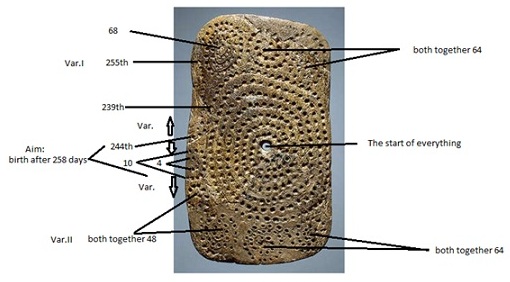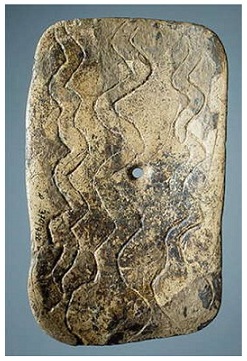
Paleolithic Preventive Medicine: The Prenatal Recording Schedule of Mal´ta
*Corresponding Author(s):
Thomas E HeiseDepartment Of Social Psychiatry, Medical University Hannover, Germany
Email:thohei@gmx.de
Abstract
Looking at archeological findings with mostly historical eyes didn´t solve the riddle of a mammoth tusk plate found in Mal´ta more than 80 years ago. Seen from the context of practical use bound into men´s worldview in a contextological way it could be suggested that fertility and pregnancy was a main issue discussed by then already. It is proposed, that people used the plate to memorize and calculate the stage of pregnancy. This can be seen as the onset of preventive medical thinking. When planning the most favorable circumstances for the birth to come, it was vital to know about the progress of time in pregnancy. It seems that about 22.000 years ago the plate helped to count it as precisely as possible.
Introduction
The archeological finding of a mammoth tusk plate with unclear incisions could be examined in a contextological way, combining interdisciplinary and transcultural thinking to give a possible solution of its meaning. The famous site of Mal´ta in Siberia was excavated by Gerasimov, one of the fathers of Siberian prehistory, from 1928 to 1930. Small Venus statues relating to fertility and other objects have been found around a small settlement with a hearth. These people [1,2] represented two sides of the hearth place, a male sitting ground and a female one. The latter one didn´t only show the Venus figurines, but also a small mammoth tusk plate with snakes in wave form on one and chiseled points on the other side [3].
Delporte writes about it: “Among these decorative objects, two findings appear to be quite exceptional: the first is a large plate of ivory, measuring 136 mm by 82mm, perforated, with on one side a décor composed of dotted spirals, on the other face three wavy snakes. The second, collected in the grave of a child with a plate similar to the previous, but less remarkable consists of a necklace composed of a large bird shaped pendant, six smaller pendants in the shape of the number eight and 12 small discoid beads. The aviform pendant and the pendants in the form of the number eight are all decorated with the 'pointillé' method. But the most important part of the art of Mal´ta is represented by an extensive series of works of figurative art. There is, currently, only one engraving: it is a rather clumsily carved on a mammoth ivory plaque. By contrast, sculpture in the round is rich and varied, it is organised into three distinct groups: realistic birds, stylised birds and female figures” [4].
Don Hitchcock wrote about this: “Plate with a hole in the centre. Mammoth tusk; carved, polished and engraved. 138 x 81 mm. Mal´ta Site (excavations by M.M. Gerasimov, 1928-1930), Siberia, the River Belaya, near Irkutsk, Russia. Maltinsko-buretskaya Culture. 23000 - 19000 BP. Photo and text: http://www.hermitagemuseum.org/. On one side of the plate we can see three snakes. The snake is rare in northern hemisphere Paleolithic art, presumably because the cold conditions precluded a wide distribution of snakes. In addition, it can be seen that the snakes have very broad heads, as though they belong to the Cobra group - yet Cobras are now known only in southern Asian localities. So the puzzle is, are the engravings of cobras, in which case how did the artist ever see them, or is there some other interpretation possible? Are the illustrations perhaps maps of rivers proceeding from glacial lakes? On the other side of the plate there is a large spiral of depressions coming out from the central hole, with several often connected spirals surrounding it”.
Findings
The inner spiral done by these engraved small holes, which could be filled with some colored material if counted for the very day, starts with a somewhat bigger hole in the very middle of this a little rounded, rectangular tablet, which marks the day man was hitting the ovulation day. This leaves us an average of 266 days about to go after conception. Well, at the height of the middle hole on the rim the spiral comes to its first end turning the spiral open to the outside with day number 244. Then it starts again with only a small half circle formed by 10 day-points, when the baby would hopefully come. The interior of this is again marked with 4 more single points – to give it a reasonable chance, before real problems may start later (Figure 1).
 Figure 1: Calendarium.
Figure 1: Calendarium.
Both opposite corners of the upper side are formed with two spirals leading into one another, forming this way 64 days in each corner. The other two, lower corners show to the right two spirals with together 48 days and on the left one bigger spiral with 68 days. But if after the first opening of the big central spiral after 244 days you do not go on to the half circle to the right and turn to the left instead, you can count to 255 before it starts entering the smaller spiral in the left corner, marked with about 64 days. Even when the photo is fine, to see the original in the Hermitage would make a difference and besides especially the corners are used by touching and holding it in the hands for its practical use. But anyhow, man is an individual living being and can never be calculated completely.
10 lunar months, which is 40 weeks or 280 days, if we start from the first day of the last menstruation which can be recognized easily – not the day of conception - , is the average time. 334 days is supposed to be the maximum time that can be survived for both, mother and baby [5]. So may be the two connected spirals after 255 days are the right ones with 48 days and still some hope which even is divided into a smaller part of 16 before entering the other spiral turning inside and getting more and more narrow – into the crisis - , till the end with day 48.
Today 90 % of the babies are born within 42 weeks which is 294 days. But of course, some of those are not coming voluntarily. They are persuaded to come out, if necessary by a caesarean operation to prevent damage for mother and baby. If it is too cold outside, they are reluctant to leave the warmth inside as well. So it makes sense to have babies in the warmer season in order to give it an easier start. But in order to do so you must know about conception and be able to calculate this. Obviously they could do so at the time of the Venus of Hohle Fels 40.000 years ago in Germany close to the Danube River and the mammoth tusk tablet at Mal´ta 22.000 years ago in Siberia near Lake Baikal (see my second article) (Figure 2).
 Figure 2: Lines.
Figure 2: Lines.
Regarding the other contents on the tablet, some hypotheses are offered. The two snakes represented on the other side may not only be the clan symbol but represent the smaller one as the female and the other one as the male, the yin and the yang, who meet to fulfill mother earth´s and nature´s fertility law. Besides, the snake has generally spoken on one side the male character, resembling the penis, and on the other side the female character, as a chthonic being going into and coming out of the earth and having closeness to the waters. May be for this reason we even have two counts on the other side with the spirals. The first 64 – spiral gives the number which is seen as the period, when like in most traditional cultures and as described in the Australian and Melanesian tribes e.g. the Asmat in Papua New Guinea [6] the ghost child or soul coming from the other realms or the world of the ancestors and spirits is around but still has to decide whether to settle in the womb. This is regarded as the fetal period and natural abortion is much less after this time when its decision was positive. When this has passed successfully we enter together with the parents now the second 64 – spiral and wait for another evidence to come. People who are still rather aware of nature and their body will be more susceptible of the first child movements by then after 128 days. This gives another signal – what all the parents want - that everything worked out fine till then. Hopefully on they go, heading to the third spiral in the corner. At the end of this time the first and not painful contractions of the mother´s uterus in order to get some training can be realized. After the fourth corner we have altogether again the same sum of 244, heading for a normal childbirth.
Conclusion
If people could already 22.000 years ago calculate the time of birth so exactly as more or less today, they obviously had an insight into many things we didn´t suspect until now. It seems possible they could be able to calculate the stars by then already, to determine the changing of the seasons and when to follow the animals best for hunting even more. It has been suggested that they used in South Africa the moon calendar [7] long before which would easily fit with this new results.
Acknowledgement
I am very grateful to Günther Haseloff (1912 – 1990) and Bettina Stengel for not giving up the lectures and courses in prehistory at the University of Würzburg (“Tres faciunt collegium”). I also want to thank Karl-Heinz Pohl and Hans-Georg Stephan for accepting me for PhD graduation in Chinese studies and prehistory. Another acknowledgement to Don Hitchcock for his trying to make archeological data known by his webside, where I came across this plate on my search and last not least I thank the The Hermitage Museum, Saint Petersburg, to give the permission for publishing their photos of the plate.
References
- The State Hermitage Museum (2022) Purchase of online Tickets. The State Hermitage Museum, Russia.
- Don's Maps (2022) Resources for the study of Palaeolithic / Paleolithic European, Russian and Australian Archaeology / Archeology. Don's Maps, Morocco.
- http://donsmaps.com/images24/ Mal´ta platehermitage.jpg
- Delporte H (1979) L'image de la femme dans l'art préhistorique. Bulletin of the French Prehistoric Society, Paris, France.
- Meducate (2022) " meducate" the new therapist network platform. Meducate, India.
- Konrad G, Asmat V (1978) Unter Papuas: Mensch und Kultur seit der Steinzeit. Frankfurt/M: Fischer, Germany.
- Marean CW (2011) Coastal South Africa and the Co-Evolution of the Modern Human Lineage and the Coastal Adaptation. In: Bicho NF, Haws JA, Davis LG (Eds.). In: Changing Coastlines and the Antiquity of Coastal Settlement. Springer, USA.
Citation: Heise TE (2022) Paleolithic Preventive Medicine: The Prenatal Recording Schedule of Mal´ta. J Altern Complement Integr Med 8: 306.
Copyright: © 2022 Thomas E Heise, et al. This is an open-access article distributed under the terms of the Creative Commons Attribution License, which permits unrestricted use, distribution, and reproduction in any medium, provided the original author and source are credited.

